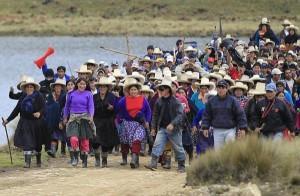from Root Force

Peru’s extractive policies have been a major source of social conflict in the last few years. In this photo from May 2009, Ashanika warriors occupy oil boat in the Peruvian Amazon.
This past week, Peru’s Minister of Energy and Mines, Jorge Merino, optimistically announced that he expects the country’s mining sector to grow 10% in 2014.
“Mining exports in 2014 are expected to be around US$27 billion,” Merino said, “and investment in that sector will be around US$10 billion.”
All that growth will come from three projects, he said: Tía Maria (in Arequipa), Quellaveco (in Moquegua) and Minas Conga (in Cajamarca). This continues the trend of the government remaining optimistic about the embattled Minas Conga mine, even as investors grow more and more skittish.
By thematically appropriate coincidence, the same week saw the United Nations Development Program issue a report lambasting Peru for pushing economic development via an extractive model, providing little benefit to most Peruvians while destroying Peru’s environment and contributing greatly to global warming.
From International Business Times:
“According to the report, Peru has a high human development index. Between 1980 and 2012, life expectancy grew by 14.2 years, the average schooling increased by 3.2 years, and gross domestic product spiked 60 percent. But Santa Cruz said that such figures hide a different reality: “The growth does not come from education or health, but from predatory activities, like [resource] extraction and mining.”
Therefore, the human development and the increase of wealth are linked to activities that cause deforestation, resource wasting and an increase of vulnerability to natural disasters. The region of Peru that grew the most, Moquegua, is devoted almost exclusively to mining.”

Indigenous highlanders march against Newmont Mining Corp’s Minas Conga gold mine, which would destroy local water supplies.
That is, although on paper Peru’s per capita income, education and life expectancy have increased, these benefits have not been spread to the general population. Furthermore, extractive activities such as mining and oil drilling destroy the land of indigenous and rural peoples, thereby leading to increased poverty and worsened health among the country’s most vulnerable populations.
This is the inevitable result of an economic system based on rampant resource consumption. Even if Peru made an effort to spread the wealth from its “predatory activities” more equitably, massive extractive projects would still degrade the environment, displace and poison rural and indigenous peoples, and fuel the runaway warming of our planet. And let’s not forget: the environmental and social impacts of Peru’s extractive industries don’t end at the country’s borders.
Peru mines so aggressively because wealthy countries are buying. Peru is the world’s second largest producer of both silver and copper, after Chile. Both of these metals (along with many others mined in Peru) are major industrial materials. Copper alone is an essential component of all electrical appliances (yes, that includessolar panels).
All of which means that Peru’s mining plays an essential role in enabling the even-more-flagrant destruction and consumption that characterizes the wealthy (“First”) world.
This isn’t an issue of capitalism vs. socialism. It’s an issue of extraction vs. sustainability. Extraction vs. sanity, really.
Thankfully, Peru and many of its Latin American neighbors are home to a growing and powerful anti-mines and anti-extraction movement. Overtly challenging the logic of both capitalist and Marxist industrialism, theseindigenous-led movements are insisting that if the global economy conflicts with good living and a healthy planet, it’s the economy that’s got to go.
And that’s a message we all should get behind.

